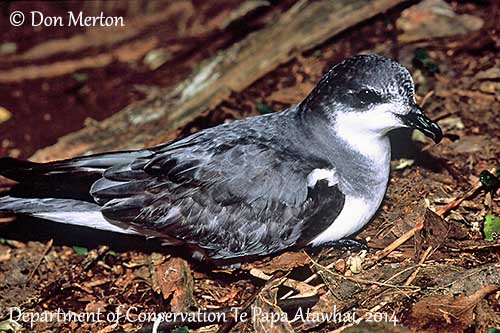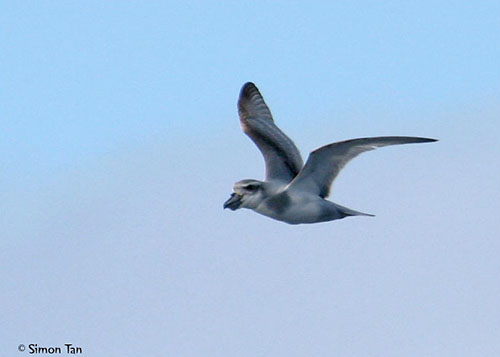
Fr: Pétrel des Chatham
Ang: Chatham Petrel
All: Chathamsturmvogel
Esp: Petrel de las Chatham
Ita: Petrello delle Isole Chatham
Nd: Chathamstormvogel
Sd: Chathampetrell
Photographer:
Don Merton,
Courtesy of Department of Conservation Te Papa Atawhai, 2014
Department of Conservation
Simon Tan (Prion de Forster)
PBase Bird galleries
Text by Nicole Bouglouan
Sources:
HANDBOOK OF THE BIRDS OF THE WORLD vol 1 by Josep del Hoyo-Andrew Elliot-Jordi Sargatal - Lynx Edicions - ISBN: 8487334105
A Complete Guide to Antarctic Wildlife by Hadoram Shirihai and Illustrated by Brett Jarrett - Edited by Guy M. Kirwan - ALUL.A Press Oy, Finland - ISBN 9519894705
BirdLife International (BirdLife International)
New Zealand birds and birding (Narena Olliver)
New Zealand bird status between 2008 and 2012
Wikipedia, the free encyclopaedia
Te Ara – The Encyclopedia of New Zealand
Page family Procellariidae
Summary cards
Chatham Petrel
Pterodroma axillaris
Procellariiformes Order – Procellariidae Family
INTRODUCTION :
The Chatham Petrel was formerly abundant in the Chatham Islands, but by 1900, its breeding range was confined to Rangatira Island (formerly South East Island) in forested areas, and until recently, it was the sole breeding site.
The species was affected by forest-habitat loss and introduced mammalian predators.
In spite of considerable recovery of the forest in the early 1950s, the numbers were declining. There were only 30 breeding pairs in the 1980s.
Actually, the Chatham Petrel was vulnerable to competition for nesting burrows from another tubenose, the Broad-billed Prion (Pachyptila vittata). Competition between them may not have been as intense in the past as it is today, probably due to the loss of the breeding habitats. There are hundreds of thousands of Broad-billed Prions breeding on Rangatira Island.
In order to reduce this competition, the Department of Conservation made considerable efforts to protect the burrows by blockading. During the first half of the breeding season of the Broad-billed Prions (July-October), blockades made with plastic garden mesh and wire were placed across the entrance of the Chatham Petrel’s burrows in July. They were removed in late October/early November, prior to the return of the petrels to the island to reoccupy their usual burrows and start to display.
The Chatham Petrel’s chicks were collected in late breeding season and translocated to Pitt and Chatham Islands which are predator-fenced sites. There, the juveniles were fed until their departure to the sea.
In addition, with help of a sound system playing the petrel calls, small breeding colonies have been successfully established on Pitt and Chatham islands.
The Chatham Petrel is endemic to the Chatham Islands were it is evaluated as Nationally Vulnerable. It spends most time of the year at sea, and comes to land only for breeding.

Title: Chatham Island Petrel - Pétrel des Chatham
Photographer: Don Merton
Date: 2004
Location: Chatham Islands Area
Description: Chatham Island Petrel, South East Island, Chatham Islands, February 2004
Department of Conservation Te Papa Atawhai, 2014
DESCRIPTION OF THE BIRD:
Biometrics:
Length: 30 cm
Wingspan: 63-71 cm
Weight: M: 205-275 g – F: 185-260 g
The adult is a medium-sized petrel. The upperparts are slate-grey to bluish-grey, with the tail slightly darker. There is a blackish M across the upperwings and meeting on the rump.
The underparts are white. The underwing is white on centre, but we can see a dark trailing edge and a conspicuous blackish patch, extending from the leading edge across the central inner wing, and ending in a broad dark axillary patch. There is just a small whitish band at base of the leading edge, forming a white patch on scapulars on closed wings. The undertail is grey with paler outer rectrices.
On the head, face and head sides below the ear-coverts, chin, throat and foreneck are white.
Crown, nape, ear-coverts, hindneck and sides of upper breast are slate-grey and blend in with the mantle.
The bill is black with strongly hooked tip. The eyes are dark brown. Legs and base of feet are pale pink, whereas outer toes and webs are blackish.
Both sexes are similar. The juvenile resembles adults.
RANGE:
The Chatham Petrel occurs on Rangatira Island in the Chatham Islands, New Zealand. The species has been reintroduced to Pitt and Chatham islands.
After breeding, it flies E and N to about 1000 kilometres from the coasts of Peru and Chile.
HABITAT:
The Chatham Petrel breeds in endemic mature forest habitat, and during the breeding season, it forages 2000/3000 kilometres SE of the Chatham Islands. The burrows are excavated on coastal lowlands and slopes.
Outside the breeding season, it remains at sea.
CALLS AND SONGS: SOUNDS BY XENO-CANTO
The Chatham Petrel male gives high-pitched, repetitive “tee,tee,tee” both in flight and on the ground. These calls may be answered by a “coooo” or “wikooo”.
The female utters deeper “yap,yap,yap” call. Both sexes produce a “purring” sound on the ground.
BEHAVIOUR IN THE WILD:
The Chatham Petrel feeds primarily on squid caught close to the water surface. The diet also includes a variable amount of small fish, crustaceans and other marine invertebrates. The squid is caught at night, when the shoals come close to the surface.
The Chatham Petrel feeds mainly on the wing by dipping while flying.
It nests in burrows often reused in several following years. The pairs are monogamous with long-term pair-bonds. The adults return to their breeding sites in late spring and prepare the burrow. They leave and return to the colony at night to avoid predation. Like other petrels, the pair spends one month at sea after mating, in order to gain fat reserves prior to the long incubation period.
The Chatham Petrel returns at sea after the breeding season, heading east and north to about 1000 kilometres from the coasts of Peru and Chile, between June and October. But sightings of birds have been reported at sea to south of the Chatham Islands.
The flight is fast, with periods of rapid wingbeats and much glides on stiff wings. In calm weather, it usually flaps and glides at lower speed.
REPRODUCTION OF THIS SPECIES:
The laying occurs between late December and early February. The Chatham Petrel breeds in colonies alongside with other petrel species, and among them, the Broad-billed Prion. Competition between them for nesting burrows is huge, and without the intensive efforts to reduce this problem, the species would be today still worse off.

Broad-billed Prion
Pachyptila vittata
We can see the large bill, typical of this species. The bird uses it to filter the water through the lamellas, and to obtain the small crustaceans included in its diet.
The Chatham Petrel nests in burrow of about 50-100cm long, excavated in friable soil under forest and scrub or fallen logs. The burrow is visited only at night.
The female lays a single white egg, and both adults share the incubation in four shifts during 46 days. At hatching, the chick is covered with sooty-grey down. It is brooded for 1-2 days, and then, the adults return at sea and feed it regularly by regurgitation. It is fed with semi-digested food and energy-rich oil from the parent’s crops, which is slowly digested.
By mid-April, the chick emerges during several nights to exercise and to find suitable trees to take-off. Parents usually abandon it at this moment and start to migrate while the chick fledges from late April to June. It will return to the colony in the second year, and it will breed at 3 years old.
PROTECTION / THREATS / STATUS:
Thanks to intensive conservation actions, the Chatham Petrel is slowly increasing its small population. These actions will be continued until a self-maintaining population is established.
However, the invasive mammalian predators are a constant potential threat in spite of active control.
The population is estimated at about 1100 mature individuals and is increasing.
But currently, the Chatham Petrel is listed as Endangered.